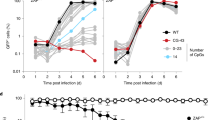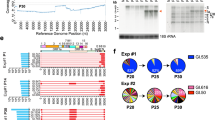Abstract
The development of general approaches for the isolation of efficient antivirals and the identification and validation of targets for drug screening are becoming increasingly important, due to the emergence of previously unrecognized viral diseases. The genetic suppressor element (GSE) technology is an approach based on the functional expression selection of efficient genetic inhibitors from random fragment libraries derived from a gene or genome of interest. We have applied this technology to isolate potent genetic inhibitors against HIV-1. Two strategies were used to select for GSEs that interfere with latent virus induction and productive HIV-1 infection based on the expression of intracellular and surface antigens. The selected GSEs clustered in seven narrowly defined regions of the HIV-1 genome and were found to be functionally active. These elements are potential candidates for the gene therapy of AIDS. The developed approaches can be applied to other viral pathogens, as well as for the identification of cellular genes supporting the HIV-1 life cycle.
This is a preview of subscription content, access via your institution
Access options
Subscribe to this journal
Receive 12 print issues and online access
$259.00 per year
only $21.58 per issue
Buy this article
- Purchase on Springer Link
- Instant access to full article PDF
Prices may be subject to local taxes which are calculated during checkout





Similar content being viewed by others
References
Holzmayer TA, Pestov DG, Roninson IB . Isolation of dominant negative mutants and inhibitory antisense RNA sequences by expression selection of random DNA fragments Nucleic Acids Res 1992 20: 711–717
Gudkov AV et al. Isolation of genetic suppressor elements, inducing resistance to topoisomerase II-interactive cytotoxic drugs, from human topoisomerase II cDNA Proc Natl Acad Sci USA 1993 90: 3231–3235
Gudkov AV et al. Cloning mammalian genes by expression selection of genetic suppressor elements: association of kinesin with drug resistance and immortalization Proc Natl Acad Sci USA 1994 91: 3744–3748
Pestov DG, Lau L . Genetic selection of growth-inhibitory sequences in mammalian cells Proc Natl Acad Sci USA 1994 91: 12549–12553
Ossovskaya VS et al. Use of genetic suppressor elements to dissect distinct biological effects of separate p53 domains Proc Natl Acad Sci USA 1996 93: 10309–10314
Garkavtsev I, Kazarov A, Gudkov A, Riabowol K . Suppression of the novel growth inhibitory p33ING1 promotes neoplastic transformation Nat Genet 1996 14: 415–420
Gallagher WM et al. Identification of p53 genetic suppressor elements which confer resistance to cisplatin Oncogene 1997 14: 185–193
Tenson T, DeBlasio A, Mankin A . A functional peptide encoded in the Escherichia coli 23 rRNA Proc Natl Acad Sci USA 1996 93: 5641–5646
Sanford JC . Applying the PDR principle to AIDS J Theor Biol 1988 130: 469–480
Baltimore D . Intracellular immunization Nature 1988 335: 395–396
Gilboa E, Smith C . Gene therapy for infectious diseases: the AIDS model Trends Genet 1994 10: 139–144
Yu M, Poeschla E, Wong-Staal F . Progress towards gene therapy for HIV infection Gene Therapy 1994 1: 13–26
Dropulic B, Jeang K-T . Gene therapy for human immunodeficiency virus infection: genetic antiviral strategies and targets for intervention Hum Gene Ther 1994 5: 927–939
Junker U et al. Intracellular expression of human immunodeficiency virus type 1 (HIV-1) protease variants inhibits replication of wild-type and protease inhibitor-resistant HIV-1 strains in human T cell lines J Virol 1996 70: 7765–7772
Butera ST et al. Oscillation of the human immunodeficiency virus surface receptor is regulated by the state of viral activation in a CD4+ cell model of chronic infection J Virol 1991 65: 4645–4653
Coffin JM . HIV population dynamics in vivo: implications for genetic variation, pathogenesis and therapy Science 1995 267: 483–489
Mansky LM, Temin HM . Lower in vivo mutation rate of human immunodeficiency virus type 1 than that predicted from the fidelity of purified reverse transcriptase J Virol 1995 69: 5087–5094
Malim MH et al. Stable expression of transdominant Rev protein in human T cells inhibits human immunodeficiency virus replication J Exp Med 1992 176: 1197–1201
Bevec D, Dobrovnik M, Hauber J, Bohnlein E . Inhibition of human immunodeficiency virus type 1 replication in human T cells by retrovirus-mediated gene transfer of a dominant-negative rev trans-activator Proc Natl Acad Sci USA 1992 89: 9870–9874
Woffendin C et al. Nonviral and viral delivery of a human immunodeficiency virus protective gene into primary human T cells Proc Natl Acad Sci USA 1994 91: 11581–11585
Malim MH, Bohnlein S, Hauber J, Cullen BR . Functional dissection of the HIV-1 Rev trans-activator: derivation of a trans-dominant repressor of Rev function Cell 1989 58: 205–214
Pearson L et al. A transdominant tat mutant that inhibits tat-induced gene expression from the human immunodeficiency virus long terminal repeat Proc Natl Acad Sci USA 1990 87: 5079–5083
Bahner I et al. Comparison of trans-dominant inhibitory mutant human immunodeficiency virus type 1 genes expressed by retroviral vectors in human T lymphocytes J Virol 1993 67: 3199–3207
Caputo A et al. Studies on the effect of the combined expression of anti-tat and anti-rev genes on HIV-1 replication Gene Therapy 1997 4: 288–295
Vandendrissche T et al. Inhibition of clinical human immunodeficiency virus (HIV) type 1 isolates in primary T lymphocytes by retroviral vectors expressing anti-HIV genes J Virol 1995 69: 4045–4052
Lui J, Woffendin C, Yang Z, Nabel GJ . Regulated expression of a dominant negative form of Rev improves resistance to HIV replication in T cells Gene Therapy 1994 1: 32–37
Chua MKL et al. Inhibition of human immunodeficiency virus type-1 by retroviral vectors expressing antisense TAR Hum Gene Ther 1994 5: 1467–1475
Plavec I et al. High transdominant RevM10 protein levels are required to inhibit HIV-1 replication in cell lines and primary T cells: implication for gene therapy of AIDS Gene Therapy 1997 4: 128–139
Lee S-W, Gallardo HF, Gilboa E, Smith C . Inhibition of human immunodeficiency virus type 1 in human T cells by potent Rev response element decoy consisting of the 13-nucleotide minimal repeat Rev-binding domain J Virol 1994 68: 8254–8264
Ulich C, Harrick D, Estes P, Gaynor RB . Inhibition of human immunodeficiency virus type 1 replication is enhanced by a combination of transdominant Tat and Rev J Virol 1996 70: 4871–4876
Miller AD, Rosman GJ . Improved retroviral vectors for gene transfer and expression BioTechniques 1989 7: 980–990
Gendelman HE et al. Trans-activation of the human immunodeficiency virus long terminal repeat sequence by DNA viruses Proc Natl Acad Sci USA 1986 83: 9759–9763
Fisher AG et al. A molecular clone of HTLV-III with biological activity Nature 1985 316: 262–265
Gudkov AV, Roninson IB . Isolation of genetic suppressor elements (GSEs) from random fragment cDNA libraries in retroviral vectors. In: Cowell IG, Austin CA (eds). Methods in Molecular Biology, vol 69: cDNA Protocols Humana Press: Totowa, NJ 1996 221–340
Johnson VA, Byington RE . Quantitative assays for virus infectivity. In: Aldovini A, Walker BD (eds).Techniques in HIV Research Stockton Press: New York 1990 71–86
Sambrook J, Fritsch EF, Maniatis T . Molecular Cloning, a Laboratory Manual Cold Spring Harbor Laboratory Press: Cold Spring Harbor, NY 1989
Gadol N, Crutcher G, Busch MP . Detection of intracellular HIV in lymphocytes by flow cytometry Cytometry 1994 15: 359–370
Author information
Authors and Affiliations
Rights and permissions
About this article
Cite this article
Dunn, S., Park, S., Sharma, V. et al. Isolation of efficient antivirals: genetic suppressor elements against HIV-1. Gene Ther 6, 130–137 (1999). https://doi.org/10.1038/sj.gt.3300791
Received:
Accepted:
Published:
Issue Date:
DOI: https://doi.org/10.1038/sj.gt.3300791



